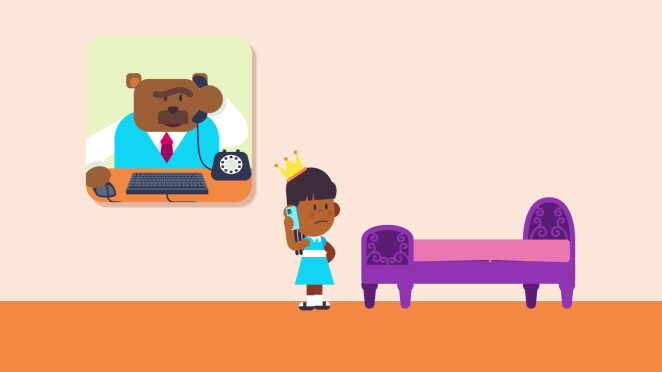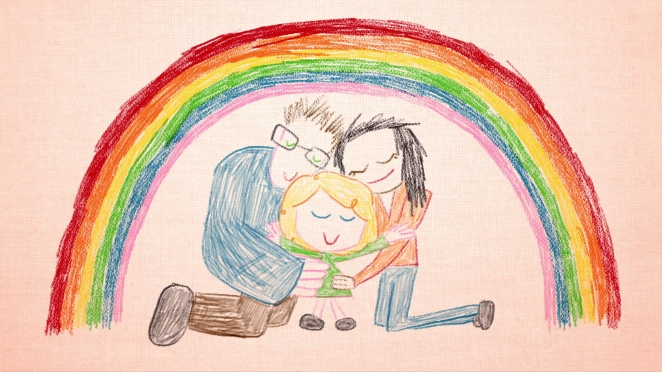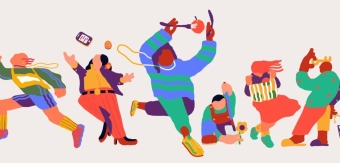How did you get into the industry?
From watching too many cartoons as a kid, honestly! As a teenager, I saved up for a Wacom tablet and started experimenting with making my own animation in Flash and Photoshop. Later, when I studied animation at the Edinburgh College of Art, we were encouraged to do work placements during our studies.
I did a few small jobs, but also got the opportunity to work on the BBC Scotland documentary series Addicted to Pleasure. This gave my portfolio a huge early boost and helped me bring in more work when I graduated. Even with that, the first couple of years after graduation were tough going, and I later did five years in-house with a company making educational apps for preschoolers before switching back to freelancing full-time.
Where are you based now and who do you work for?
I’m currently based in Prague, Czech Republic, where I work as a freelance animator. The wonderful thing about freelancing is that every job is completely different - one month I might be working on an animated explainer about diabetes, the next I’m animating vultures for a music video.

Most importantly, every client also has their own specific needs and requirements, which makes each new project a fresh challenge. Over the years I’ve done work for big multinational clients, but also smaller local businesses, individuals and charities.
If you weren’t in your current industry, what would you be doing?
If we ignore all the other fields of animation, then perhaps particle physics! I loved maths and science at school so much that I very nearly went to study physics instead of art – after all, it felt like a much less risky career choice. But in the end I just couldn’t see myself in a lab coat, so here I am.
Can you explain your creative process? What makes it unique?
That’s a great question – and difficult to answer because no two projects are the same! It’s very easy to settle into a workflow that’s comfortable, but different clients’ brands, budgets and deadlines all favour different approaches, and I think it’s important to be able to adapt to the project at hand.
Generally speaking though, each project begins with a conversation about what the client needs to communicate and who the target audience is. After that the style and format usually follows naturally - should the video feel hi-tech or handmade? Is the tone humorous or serious?

Then after some quick sketches on paper, I’ll usually have a good idea of the direction I’d like to take the project, so I’ll work up some designs and storyboards digitally to share with the client. Although it’s tempting to rush ahead to production, I always find it’s worth investing more time into the pre-production stages: script, moodboards, style frames, storyboards and animatics.
Making sure the client is fully on-board at each stage means there are usually very few revisions needed during animation, which saves time and budget in the long run.
How would you describe your style?
Playful, bright and fun! How I design and animate is constantly evolving and adapting to meet my clients’ needs, but my favourite projects are the ones that make me smile, and I hope they make other people smile too.
Which individuals do you gain inspiration from? Do you have any heroes in the industry?
Out of people I know, Oana Nechifor (creativepool.com/oananechifor) and Jiří Mikovec (behance.net/mikovecjir5bc4) are a constant inspiration to me, and working with them always motivates me to push my work a bit further.
Outside of my circle of contacts I’m consistently blown away by work done by CRCR (crcr.fr), The Line (thelineanimation.com) and Animade (animade.tv).
What tips would you give to aspiring creatives looking for work?
Tailor your showreel or portfolio to each job you apply for - when starting out, it’s perfectly normal to have a less focused portfolio, but only show the client the type of work you think they want to see.
Be friendly! Your portfolio is only half the story - the client has to want to hire you as a person, too. Being punctual and polite goes a long way.

Avoid working for free (or for experience/exposure). I think many of us have been in situations where we take on unpaid or badly paid work in the hope that it’ll lead to something better, but in my experience it never does.
When neither you nor the client is financially invested in your involvement, the end result suffers and is rarely something that you’d feel proud to add to your portfolio. If you do find yourself with a lot of downtime between jobs, I’d strongly suggest working on personal projects or taking an online course to learn a new skill instead.
What tips would you give to other professionals to get more clients?
Be reliable. Ninety percent of my new clients have been recommendations or referrals from existing clients or colleagues. If you do a good job, deliver on-time and on budget, and are pleasant to work with, the chances are clients will want to hire you again and recommend you to their network.
It sounds obvious, but I’ve worked with a surprising number of animators who fail on one or more of these marks, and they don’t often get hired again.
What kind of tools/kit/software could you not do without?
Although I animate all my projects digitally, my favourite tool is actually my sketchbook - I use it for all sorts: notes from meetings with clients, budget estimates, storyboard thumbnails, design sketches, ideas for personal projects. I prefer physical sketches for these kinds of things, and having everything in one place makes it simple to keep track of.
On the digital side, Adobe Illustrator and After Effects are my go-to programs, so the Overlord plugin by Adam Plouff (battleaxe.co/overlord) revolutionised my workflow for bringing complex vector scenes into After Effects all ready to animate. I regularly use plenty of other AE plugins and scripts, too - Deep Glow, RubberHose, EaseCopy, and Paste Multiple Keyframes, to name a few.
Outside of After Effects, I use ClickUp (app.clickup.com) for project management and time tracking, and Storyboarder (wonderunit.com/storyboarder) if I’m doing longer or more complex storyboards.
What’s your secret to staying inspired and motivated?
Nowadays there’s so much fantastic art and animation easily accessible online that I don’t think finding inspiration is really a problem anymore. Staying motivated, on the other hand, can be a bit trickier.
When you’re freelance, you’re sort of your own boss, which is great, but it also means there’s nobody else holding you accountable, so self-discipline is really important. I’m fortunate enough to have a job doing something I love, but even so, some parts of the process can be monotonous and repetitive, and I have to find a way to get through that.

In my case this means having a stable workday routine, sticking to deadlines, and planning ahead to make sure I’m not rushing anything at the last minute. It’s not very glamorous, but at the end of the day, this is my job, and if I don’t do it, I’m not going to have any income.
What’s the work achievement you’re most proud of?
Leaving the security of employment to work freelance fulltime was a scary step to take, but I’ve found it to be incredibly rewarding.
What is the one thing that you would change about the industry?
Luckily it’s not something that I’ve experienced often, and it varies from field to field, but the animation industry as a whole still has issues with crunch culture - the idea that it’s normal to work long hours of overtime at the end of a project to meet tight deadlines. It’s an unhealthy and unfair practice, and definitely something that I’d like to see changed.
Any websites, books or resources you would recommend?
I’ve collected a lot of books on animation, but when it comes to basic animation principles, The Animator’s Survival Kit by Richard Williams and The Illusion of Life by Frank Thomas and Ollie Johnston are still the best books out there by a long shot.

For specific tips and tricks, YouTube is also a fantastic resource - I’m a big fan of Ben Marriot’s YouTube channel. Not only does he have a great sense of humour, but he also showcases really creative and elegant solutions to motion design problems.
The Freelance Manifesto by Joey Korenman is a must-read for anyone thinking about going freelance, both for practical tips and just general motivation about making the jump to being self-employed.




